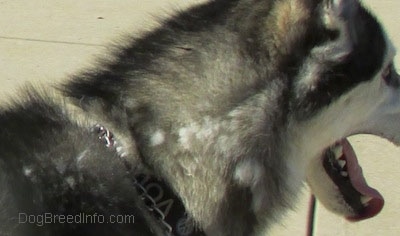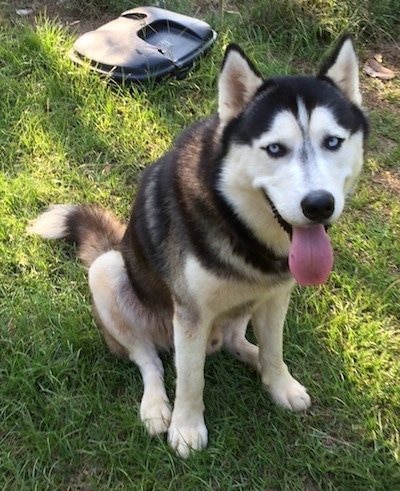Happy Furball Friday, Missians!
Glad you could join us for another edition of Missy's Blog. Hopefully this Friday morning finds all of you well. I hope this will be a three day weekend for most of you. Here in the US, Monday is a holiday for Dr. Martin Luther King Jr.'s birthday. Luckily for me, I also took off the Tuesday after. I was supposed to be on vacation all next week, but a kink got thrown in my plans--so for now, vacay's postponed; but that's good for you guys because it means I get to keep posting blog entries and be with you all for another Missy Show next Saturday.
Don't forget to check me and D out on tomorrow's show to hear part two of "New Year Pet News" tomorrow at 5pm Central.
Okay, I'll give you your Pet Trivia question first, then go on to our Featured Pet of the Week. Here's this week's trivia question:
What date and time will this year's Puppy Bowl be held this year? And you get bonus points if you can name the date and time for The Kitten Bowl too, (and in case you were wondering, we will be live tweeting for both events again this year). If you think you know the answer to today's trivia questions, you can tweet them to us at www.twitter.com/missyshow, or post it on our Facebook page at www.facebook.com/missy.show44. The answers will be given out live on tomorrow's Missy Show episode.
Now my fine furry pet lovers, let's move on to our Featured Pet of The Week, The Siberian Husky. Since it's Winter, and we've finally had some chilly mornings here in the South, it got me to thinking about cold weather animals; and what better pet would be an example than the Siberian Husky? So sit back and enjoy these facts about this super "cool" animal. Today's info comes once again from our friends at www.dogbreedinfo.com.




Glad you could join us for another edition of Missy's Blog. Hopefully this Friday morning finds all of you well. I hope this will be a three day weekend for most of you. Here in the US, Monday is a holiday for Dr. Martin Luther King Jr.'s birthday. Luckily for me, I also took off the Tuesday after. I was supposed to be on vacation all next week, but a kink got thrown in my plans--so for now, vacay's postponed; but that's good for you guys because it means I get to keep posting blog entries and be with you all for another Missy Show next Saturday.
Don't forget to check me and D out on tomorrow's show to hear part two of "New Year Pet News" tomorrow at 5pm Central.
Okay, I'll give you your Pet Trivia question first, then go on to our Featured Pet of the Week. Here's this week's trivia question:
What date and time will this year's Puppy Bowl be held this year? And you get bonus points if you can name the date and time for The Kitten Bowl too, (and in case you were wondering, we will be live tweeting for both events again this year). If you think you know the answer to today's trivia questions, you can tweet them to us at www.twitter.com/missyshow, or post it on our Facebook page at www.facebook.com/missy.show44. The answers will be given out live on tomorrow's Missy Show episode.
Now my fine furry pet lovers, let's move on to our Featured Pet of The Week, The Siberian Husky. Since it's Winter, and we've finally had some chilly mornings here in the South, it got me to thinking about cold weather animals; and what better pet would be an example than the Siberian Husky? So sit back and enjoy these facts about this super "cool" animal. Today's info comes once again from our friends at www.dogbreedinfo.com.
Siberian Husky(Husky) (Sibe)

This is Teddy the red and white wooly Siberian Husky with blue eyes at 5 1/2 years old. The longhaired wooly coat (sometimes spelled woolly or wooley) comes from a resessive gene and is not in most kennel club's written standard.
The Siberian Husky
| |
An Awesome Pet to Consider
| |
Description
|
Siberian Huskies are strong, compact, working sled dogs. The medium-sized head is in proportion to the body, with a muzzle that is equal in length to the skull, with a well-defined stop. The color of the nose depends upon the color of the dog's coat. It is black in gray, tan or black dogs, liver in copper dogs and flesh-colored in pure white dogs. The medium-sized, oval-shaped eyes are moderately spaced and come in blue, brown, amber or any combination thereof. Eyes can be half blue and half brown (parti-eyed), or dogs can have one blue eye and one brown eye (bi-eyed). The erect ears are triangular in shape, and set high up on the head. The teeth meet in a scissors bite. The tail is carried over the back in a sickle curve, not curved to either side when the dog is excited. The large "snow shoe" feet have hair between the toes to help keep them warm and for gripping on ice. Dewclaws are sometimes removed. The medium-length, double coat is thick and can withstand temperatures as low as -58° to -76° F (-50° to -60° C). The coat also comes in a longhaired variety called a wooly coat. The wooly (sometimes spelled woolly or wooley) coat length comes from a resessive gene and is not in most of the kennel club's written standard. Coat colors include all, from black to pure white, with or without markings on the head. The face mask and underbody are usually white, and the remaining coat any color. Examples of common colors are black and white, red and white, brown, gray and white, silver, wolf-gray, sable and white, red-orange with black tips, dark gray and white. Piebald is a very common coat pattern.
|
Temperament
|
Siberian Huskies are loving, gentle, playful, happy-go-lucky dogs that are fond of their families. Keen, docile, social, relaxed and rather casual, this is a high-energy dog, especially when young. Good with children and friendly with strangers, they are not watchdogs, for they bark little and love everyone. Huskies are very intelligent and trainable, but they will only obey a command if they see the human is stronger minded than themselves. If the handler does not display leadership, they will not see the point in obeying. Training takes patience, consistency and an understanding of the Arctic dog character. If you are not this dog’s 100% firm, confident, consistent pack leader, he will take advantage, becoming willful and mischievous. Huskies make an excellent jogging companion, as long as it is not too hot. Huskies may be difficult to housebreak. This breed likes to howl and gets bored easily. Does not do well if left alone for a long period of time without a great deal of exercise beforehand. A lonely Husky, or a Husky that does not get enough mental and physical exercise can be very destructive. Remember that the Husky is a sled dog in heart and soul. It is good with other pets if raised with them from puppyhood. Huskies are thrifty eaters and need less food than you might expect. This breed likes to roam. Siberian Huskies can make wonderful companions for people who are aware of what to expect from these beautiful and intelligent animals and are willing to put the time and energy into them.
|
Height, Weight
| Height: Males 21 - 23½ inches (53 - 60 cm) Females 20 - 22 inches (51 - 56 cm) Weight: Males 45 - 60 pounds (20 - 27 kg) Females 35 - 50 pounds (16 - 22½ kg) |
Health Problems
|
Prone to hip dysplasia, ectopy (displacement of the urethra), eye issues such as juvenile cataracts, PRA (primarily in male dogs), corneal dystrophy and crystalline corneal opacities. Breeders can get hip screenings from the OFA and eye screenings yearly from a canine ophthalmologist (AVCO) and register the exam through CERF and SHOR). Also prone to a skin issue known as zinc responsive dermatitis, which improves by giving zinc supplements.
|
Living Conditions
| They are not usually recommended for apartments, however they can live in apartments if well trained and properly exercised. Siberian Huskies are very active indoors and do best with a fenced-in large yard. Because of their heavy coats, these dogs prefer cool climates. One has to use common sense with respect to maintaining them in the heat by providing adequate shade and air conditioning. This breed prefers to live in packs. |
Exercise
| Siberian Huskies need a fair amount of exercise, including a daily walk or jog, but should not be excessively exercised in warm weather. They need a large yard with a high fence, but bury the wire at the base of the fence because they are likely to dig their way out and go off hunting. |
Life Expectancy
| About 12-15 years. |
Grooming
|
The coat sheds heavily twice a year. During that time they need to be brushed and combed daily.
|
Origin
|
Siberian Huskies were used for centuries by the Chukchi Tribe, off the eastern Siberian peninsula to pull sleds, herd reindeer and as a watchdog. They were perfect working dogs for the harsh Siberian conditions: hardy, able to integrate into small packs, and quite happy to work for hours on end. The dogs have great stamina and are lightweight. Native to Siberia, the Husky was brought to Alaska by fur traders in Malamute for Arctic races because of their great speed. In 1908 Siberian Huskies were used for the first All-Alaskan Sweepstakes, an event where mushers take their dogs on a 408-mile long dogsled race. The dogs gained popularity in 1925 when there was a diphtheria epidemic in Nome, Alaska. Siberian Huskies were used to bring in the much needed medicine to the people. In the early to mid-1900s Admiral Byrd used the dogs in his Antarctic Expeditions. During World War II the dogs served on the Army’s Arctic Search and Rescue Unit. The Siberian Husky’s talents are sledding, carting and racing. The Siberian Husky was recognized by the AKC in 1930.
|
Group
| Northern, AKC Working |
Recognition
| CKC, FCI, AKC, UKC, KCGB, CKC, ANKC, NKC, NZKC, APRI, ACR, DRA, NAPR, ACA |
CKC = Continental Kennel Club
FCI = Fédération Cynologique Internationale AKC = American Kennel Club UKC = United Kennel Club KCGB = Kennel Club of Great Britain CKC = Canadian Kennel Club ANKC = Australian National Kennel Club NKC = National Kennel Club NZKC = New Zealand Kennel Club APRI = American Pet Registry, Inc. ACR = American Canine Registry DRA = Dog Registry of America, Inc. NAPR = North American Purebred Registry, Inc.ACA = American Canine Association Inc. |

This image shows how the Husky's coat comes out in clumps during shedding season. Brushing the dog helps to remove the hair before it gets all over the house.
________________________________________

Adult Siberian Husky with brown eyes
________________________________________

Comments
Post a Comment